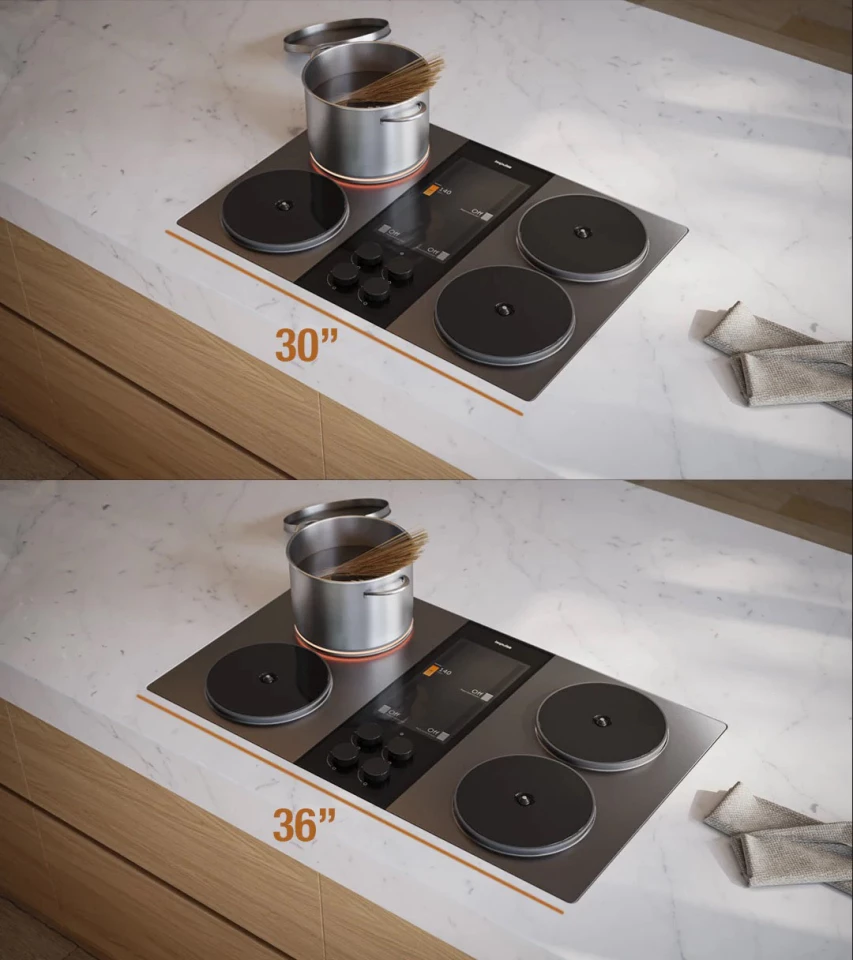I’ve been an enthusiast cook for 40 years, and I have gathered some nice knives and cookware. But I’ve never much cared what stove I was using – beyond a general preference for gas or induction.
Meanwhile San Francisco startup Impulse Labs has been quietly working away on the first cooktop I’ve seen that has made me say to myself: One day I’ll have one of those. Impulse started shipping 30-in (76-cm) units in August, and recently opened preorders for a 36-in (91-cm) format it says it will ship in January.
The Impulse is a battery-assisted induction design that shares much with the Copper Charlie stove that also became available across the US in August. Like the Charlie, the Impulse is powered directly by a lithium-iron-phosphate (LFP) battery, and like the Charlie’s, the Impulse’s battery can deliver a lot more current to its four induction elements than it pulls from the standard household electrical socket that charges it.
Therefore, again like the Charlie, the Impulse can replace a gas or electric cooktop in most dwellings, with no more changes to the building’s wiring than you’d need if you wheeled in a new fridge.

The direct parallels end there though, because Impulse has gone a lot further than Copper in exploiting the heat-transfer opportunities modern battery tech brings to cooking. You can guess it’s done something special from its having priced its four-element cooktop at US$6,000 – no less than Copper has been asking for the Charlie, a complete stove that comes with a much bigger battery and an impressively specified convection oven.
Whereas Copper has built a plug-in alternative to premium mains-supplied induction ranges, Impulse has designed its plug-in cooktop to outperform every other cooktop of any kind – and by a big margin.
The headline number is the power output available from each Impulse element: 10 kW. That’s more than three times as much as the 2.8-kW elements that come with a Charlie – and that allow the Charlie to match (or better, since it has four of them) high-end mains-direct induction competitors.
Why would you want 10 kW? Because it will bring a pot of water or a heavy skillet to your desired temperature a lot faster than 3 kW. And five times faster than you’re likely to achieve with a big domestic gas burner, Impulse says – claiming that 1 liter (1 quart) of water will be bubbling in just 40 seconds.
Experienced cooks will know that this matters, and not principally for feeding hungry mouths sooner. Cooking usually means coordinating in real time several parallel processes, a cognitive challenge complicated by long pre-heats for your cookware.
You want to serve pan-seared fish with boiled chat potatoes? When do you start pre-heating the pan, so that the fish is done just as the potatoes are tender? While your timing rarely needs to be perfect, the eating is better when the timing is close. With very fast heating you’ll be closer more often.
You’ll also be better placed to correct oversights: Dammit the fish is nearly there and I’ve forgotten to pre-boil a steamer for the asparagus!
Ultra-fast heating isn’t the only innovation Impulse is offering. But it’s worth pausing to look at how it’s got there when others have not.
In a nutshell, its founders have seen that a battery-driven induction element sidesteps the two factors that limit heat-transfer rates in a kitchen: safety, and established infrastructure.

Safety, because unlike gas and traditional electric elements, induction elements don’t get hot themselves. Therefore, you can safely make them much more ferocious.
Infrastructure, because a big battery can deliver a lot more current to the elements than standard domestic wiring can handle.
Induction elements generate heat by inducing fluctuating magnetic fields in compatible cookware. Notionally (but not technically), they heat ferrous metals much like microwave ovens heat foods.
Impulse says it custom-designed in-house the cooktop’s 9-in (23-cm) circular elements, and it didn’t stop at giving them very high power.
They’re accompanied by sensors that pick up the temperature of the pan they are heating. Their control circuitry allows you to set a target temperature, shown on a 12.8-in (32.5-cm) display placed centrally on the cooktop, and Impulse says that its elements can maintain that temperature to within a single degree.
Thus it should be easy to avoid overheating your skillet – another possibility against which cooks need to be vigilant. And you can learn and set optimal temperatures for pancakes, butter sauces, chocolate, and other concoctions.
Four control knobs sit on the Impulse cooktop alongside the display, and I’ve used sit here advisedly: they’re attached not mechanically but magnetically, and can be lifted off when cleaning. Sensors beneath the cooktop’s glass surface detect their positions.

Obviously, the precision control also allows you to set an accurate, sustained simmer, whatever the volume of the dish you are simmering. And because the element doesn’t get hot, as with any induction stove you can bring the temperature down faster too.
Anticipating that customers for such a powerful heat source might be concerned about safety, Impulse says it has had its cooktop certified as meeting UL 858, the US safety standard for household electric ranges – a first for a kitchen stove of its type.
So what’s the catch, apart from the cost? There are a few, even if they seem small alongside the performance.
The four elements don’t sit flush with the cooktop surface, a decision made partly to protect the central display and partly to hold down the depth of the unit. That means it won’t be as easy to clean as the many induction stoves that provide a uniformly flat cooking surface, and it won’t as easily handle big, non-circular pans such as an oven-to-stovetop iron baking tray.
A second drawback is the below-bench depth of the unit, which houses a 3-kWh battery centrally beneath the elements: it goes down 6.5 in (16.5 cm). That’s deeper than many gas and mains-powered alternatives, and it means you might not be able to drop it in to your existing cutout above a standard under-bench oven. So yes, you won’t need to rewire your house, but you may need to remodel your kitchen – to include a high-mount oven, for example.
Then there’s the bigger, 36-in format’s retaining just the four elements. A 36-inch gas cooktop will typically give you five burners, one at each corner and a larger one in the center. And mains-direct induction cooktops of that breadth or wider may have more than four elements, more space for broad cookware, and the capacity to link elements when using long cookware.
Plus, the 36-in size will cost $7,000.

We’re talking meal-prep luxury here, and it’s luxury that many of us, perhaps most, may not need or want. After all, any of us using gas or traditional electric stoves can create mouth-watering dishes much more easily than our ancestors could when their best source of heat was a wood fire inside an iron box.
Nevertheless, if Impulse’s claims for the unit stand up – and early reports say they do – I don’t find it hard to imagine its precision high-power concept inspiring an array of imitators and a scale-driven reduction in costs. Which might bring us to a place where we look back at stoves widespread today as unwieldy and primitive. Not to mention unhealthy and wasteful: the advantages of induction on both fronts are well documented.
Source: Impulse Labs.








